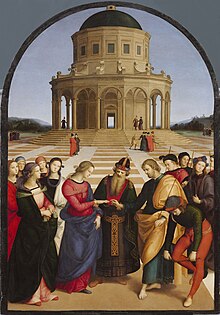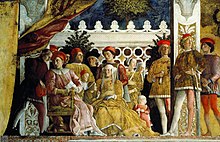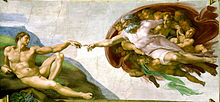Pintura renacentista de Italia
El proto-renacimiento comienza con la vida profesional del pintor Giotto e incluye a Taddeo Gaddi, Orcagna y Altichiero.
En el Alto Renacimiento destacan Leonardo da Vinci, Miguel Ángel, Rafael, Andrea del Sarto, Correggio, Giorgione, las obras tardías de Giovanni Bellini y Tiziano.
El período Manierista incluye las obras tardías de Miguel Ángel así como a Pontormo, Parmigianino, Bronzino y Tintoretto.
Entre estos, se encontraban los textos de filosofía, poesía, teatro, ciencia, arte, y teología cristiana temprana.
Las iglesias también encargaban retablos, que se pintaban con témpera sobre madera y más tarde al óleo sobre lienzo.
Al principio eran casi siempre perfiles formales, pero más tarde se popularizaron los bustos con imagen de tres cuartos.
Otros temas se tomaban de la vida contemporánea, algunas veces con sentido alegórico y otras con fines meramente decorativos.
Les encargaron principalmente pinturas religiosas, entre ellos grandes retablos mostrando a la Virgen y el Niño.
[7] Giotto, posiblemente influenciado por Pietro Cavilling y otros pintores romanos, no basó sus pinturas en ninguna tradición, sino que se guio por sus propias observaciones.
Están bien plantadas en el suelo, son anatómicamente correctas, las prendas que visten tienen una estructura y peso.
En los rostros que pinta Giotto se aprecia alegría, ira, desesperación, vergüenza, despecho y amor.
Son muy simples, en colores apagados, y transmiten una emoción intensa, pues el propósito del artista era plasmar visualmente las revelaciones espirituales.
El interior del domo está decorado con un enorme mosaico de Cristo que se cree fue diseñado por Coppo di Marcovaldo.
Tiene tres grandes portales, el central estaba cubierto en esa época por un juego de puertas creado por Andrea Pisano ocho años antes.
Cada panel muestra un fuerte estilo clasicista indicando la dirección en la cual se movía la filosofía y el arte en ese tiempo.
Desde esta época la perspectiva lineal fue entendida y empleada regularmente, como lo hizo Perugino en su obra Entrega de las llaves a San Pedro en la Capilla Sixtina.
Taddeo Gaddi en su escena nocturna en la capilla Baroncelli demostró como se podía utilizar la luz para crear drama.
En el siglo XV y primera mitad del XVI, un taller dominó la producción de Maddonas sobre los demás.
Luca della Robbia, famoso por su galería cantoria en la catedral, fue el primer escultor en utilizar terracota vidriada para esculturas grandes.
Desafortunadamente, el edificio fue destruido casi por completo durante la Segunda Guerra Mundial, y solo son conocidos por fotografías, en las cuales se aprecia un gran sentido de perspectiva.
La pintura de Cosmè Tura es altamente distinguida por incorporar un estilo tanto Gótico como Clasicista al mismo tiempo.
Tura colocaba a figuras Clásicas como si fuesen santos, rodeándolos de elementos luminosos, perfección surreal y vestimentas que parecieran estar fabricadas en cobre.
[12] La familia de Borso d'Este había construido un gran corredor para banquetes conocido como el palazzo Schifanoia.
Se convirtió en la nueva Eva, representaba el amor inocente e incluso llegó a ser un símbolo de la virgen María.
Domenico Ghirlandaio pintó su propia versión, con una bella Madonna italiana y retratándose a sí mismo como uno de los pastores.
[12] En 1477, el papa Sixto IV remplazó la antigua capilla del Vaticano, en la cual muchos servicios papales se llevaban a cabo.
Pero fue en la pintura donde se le reconoció y admiró más en su propia época, él dibujaba a partir del conocimiento que adquiría en otras áreas.
Sin embargo, Miguel Ángel tenía en mente otro esquema mucho más complejo tanto en diseño como en iconografía.
Esas Madonnas fueron reproducidas por otros miembros del estudio Bellini, por ejemplo Circuncisión de Jesús existe en 4 o 5 versiones casi idénticas.
[12][33] Las vidas de Miguel Ángel y Tiziano se extendieron en la segunda mitad del siglo XVI.



















